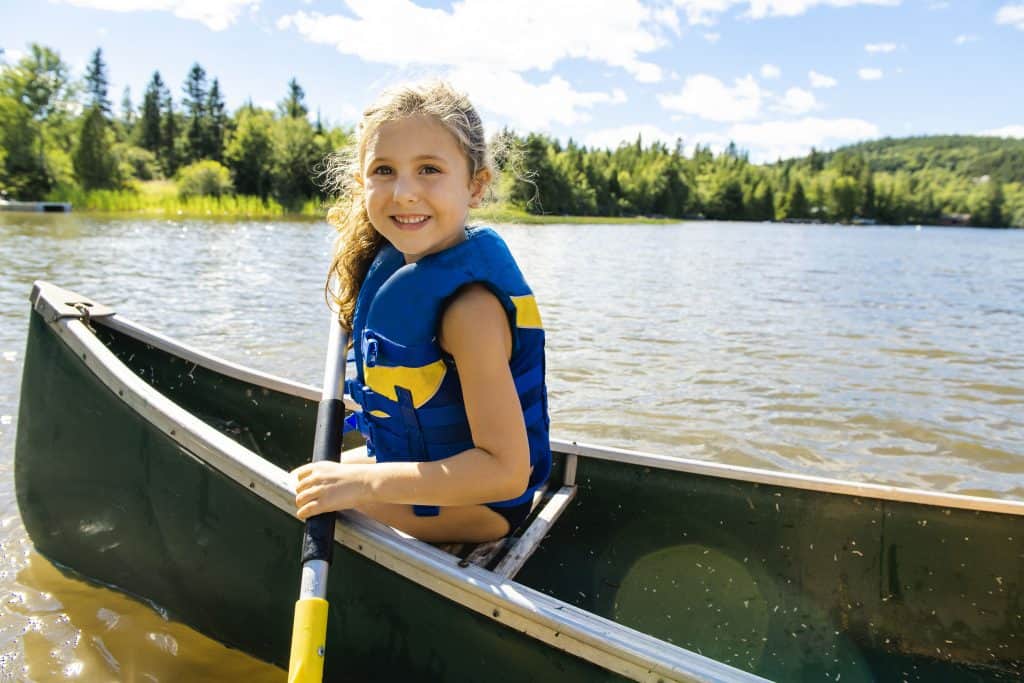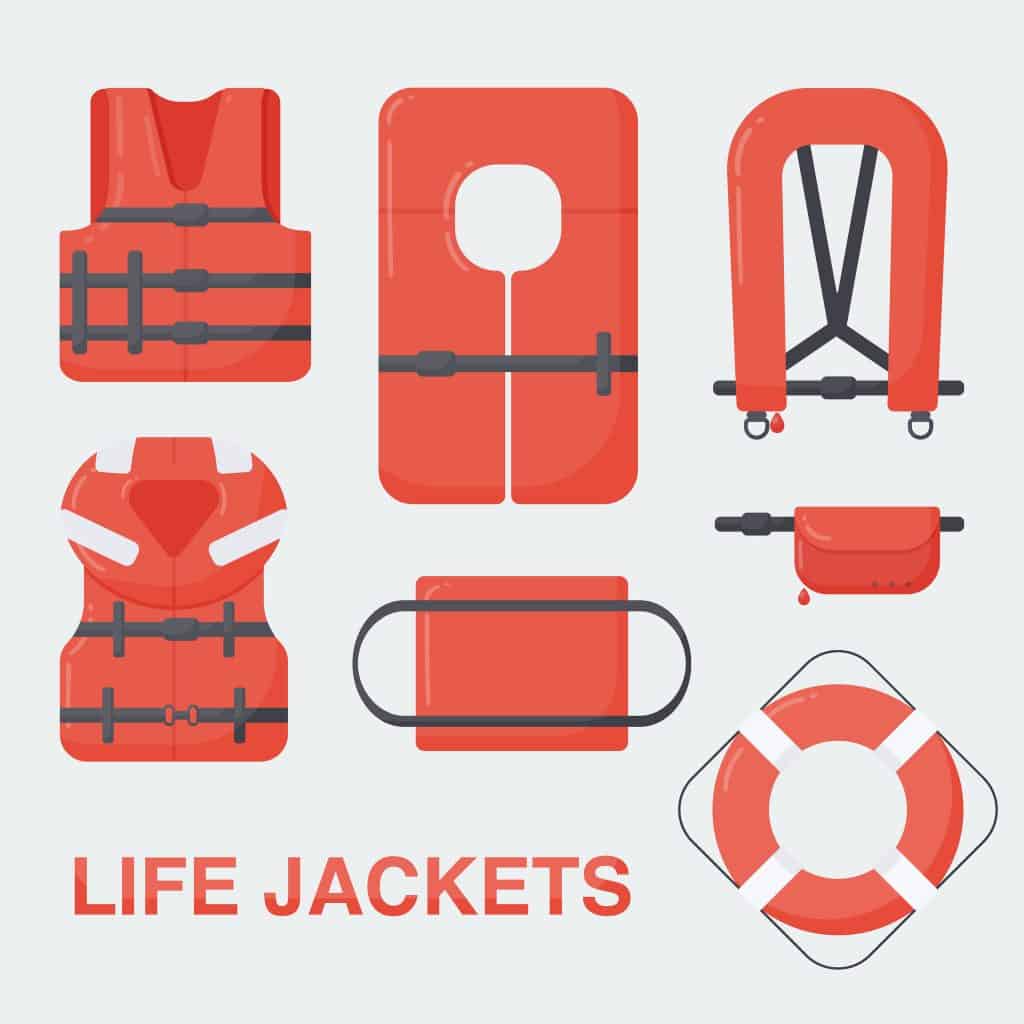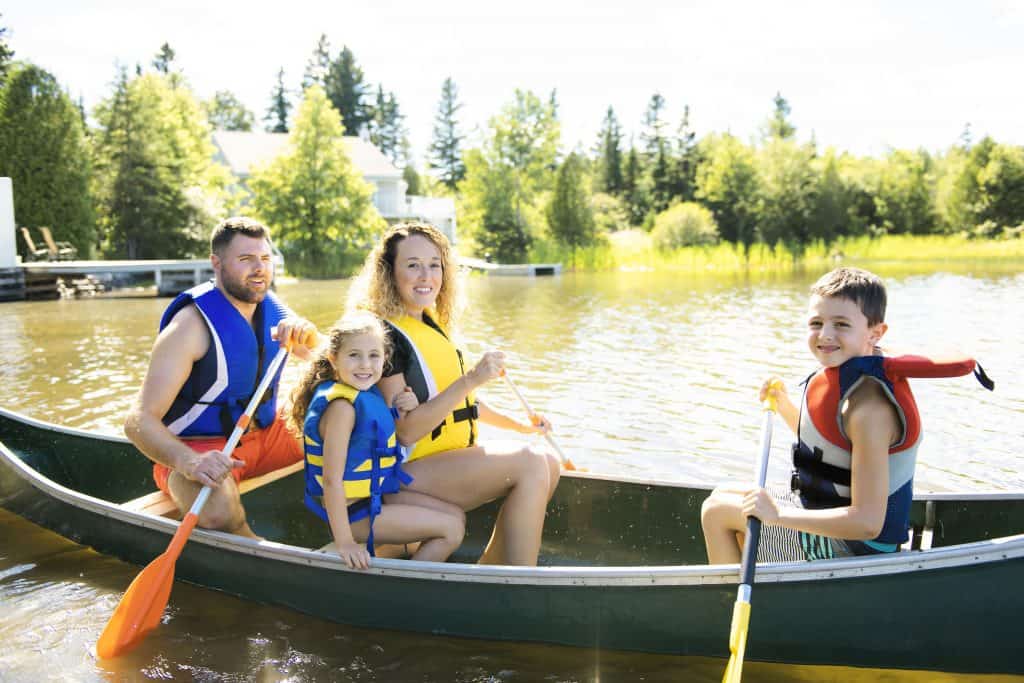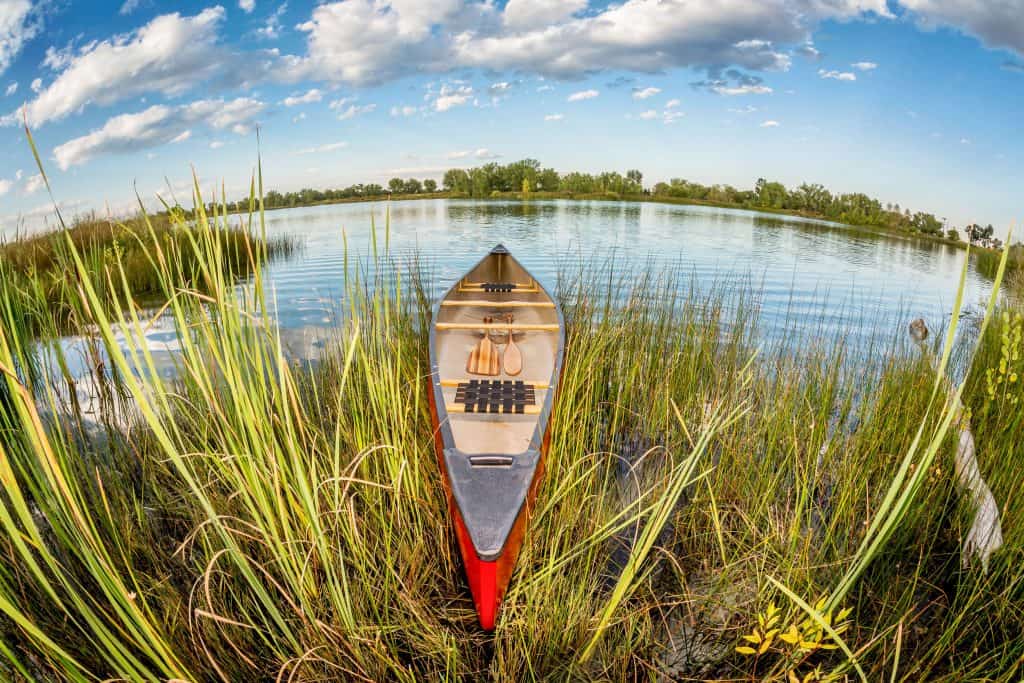
Canoes, unlike most other boats, don’t require much Coastal Guard required equipment. However, there still are things that every canoe needs to have to keep its occupants safe.
The Coast Guard requires these 5 pieces of equipment for a canoe:
- Life Jackets
- A Sound Producing Device
- A Navigational Light
- Knowledge of Navigational Rules and Pollution Regulations
- Visual Distress Signals
With these requirements, there are still different types that are needed. It’s best to know what you need and have what’s correct before heading out on the water. The better you’re prepared, the safer you are.
Most of these requirements are for boats under 16 feet, but as the average canoe is about 17 feet, these requirements will be needed for all canoes, and of course, it’s better to be safe than sorry.
1. Life Jackets
Life Jackets, or Life Vests, or PFDs (Personal Flotation Devices) are required by the Coast Guard. There are 5 different types of PFDs and the Coast Guard requires one type per person on board.
Type I PFD – These life jackets are for rough or secluded waters where rescue might take a while. They have the most buoyancy and will turn most unconscious people into a face-up position in the water. They are bulky but are the most buoyant and are most likely to be used by commercial vessels.
Type II PFD – These life jackets are used for calm inland waters, where rescue will not take long. They have a basic design, are less bulky and less expensive, but not super comfortable.
Type III PFD – These life jackets are best for most paddlers where rescue is quick. They offer freedom to move, and they provide comfort. These life jackets will keep you in a face-up position but you have to keep your head back to keep water out of your face.
Type IV PFD – These flotation devices are meant to be thrown into the water to a conscious person who is in trouble. It is a backup to a normal PFD, it’s like a life ring or floatable cushions. These PFDs are not meant to be worn and they are not required for canoes or kayaks.
Type V PFD – These life jackets are best for special activities. For the Coast Guard to approve of these PFDs they must be worn at all times and must be labeled for that activity, i.e kayaking or whitewater rafting.
PFDs must all be approved by the Coast Guard and worn while inside the boat. Make sure that you are aware of what type you need.
Sizing for canoes is important and is measured on body weight and chest size. Make sure that your life jacket fits you properly.
Also, life jackets can be and should be bought for small children and for dogs.
2. Sound Producing Device
A sound producing device is required for all canoes and kayaks. The device is used to signal intentions and positions. All boats under 20 meters (65 feet) must have an onboard means of making an efficient sound.
A sufficient sound producing device can be anything from a bell or a whistle to a horn, as long as it can be audible from at least a half a mile away. Air horns work great and are usually the best option.
3. Navigational Light
Navigational Light on small and non-motorized boats do not have to have lights as a big boat would. Usually, they only require to have a lantern or flashlight that displays white light.
A canoe can have lights on both sides and stern lights but most people just use a small LED lantern, that’s waterproof and can be lashed down. The white display light should be seen from a 360-degree radius.
Navigational lights on the stern mean that the boat is heading away from you, side light and a stern light the boat is heading across you, and if you see both side lights the boat is heading towards you.
Navigation lights are to be used from sunset to sunrise.

4. Navigation Rules and Pollution Regulations
Navigation rules are required for you to know in whatever water and state you’re in. All boaters should be familiar with the rules, especially for crossing, overtaking, and head on meetings situations.
Canoes also don’t need pollution regulation plaques, however, the Coast Guard is watchful and all boaters are on the honor system.
5. Visual Distress Signals
Visual Distress Signals (VDS) are required on all boats. Canoes out on the water between sunset and sunrise are required by the Coast Guard to hold at least one of the two pieces of equipment: flares, or pyrotechnics.
There must be at least 3-night flares, or 3 night/day flare combinations, or 1 electronic distress signal. Here is a video about VDSs from the Washington State Coast Guard:
And here is some more information about VDSs:
Safety Equipment: Not Required but a Good Idea
Although the Coast Guard only requires these 5 pieces of equipment there are many other things that boaters can keep onboard to keep them safe and provide them with extra precautions.
Here are 12 more things you can have onboard that help increase safety while canoeing.
1. Float Bags
Float bags are like airbags for cars and are made for self-rescue situations. They increase the buoyancy and maneuverability of the canoe. Therefore, these are good things to pack the canoe with. However, make sure that the location of the float bags will not cause entanglements when they are in use.
Float bags are great for displacing water and they come in multiple shapes and sizes depending on the shape and size of the canoe. The material is made to not stick and to be durable. They can be tied to the canoe and most have lifetime warranties.
They can range from about 25 to 75 dollars.
2. Helmet
Helmets are a great added safety, especially when on rough water. While a life jacket can keep you above water, it can’t do anything to protect you from hitting your head on a rock if you are thrown from the boat.
Water helmets are different from regular helmets in that they provide better coverage to potential injuries. Water helmets are made to cover the ears, the back of the head, and the top of the neck more than just a regular bike helmet. The main reason to invest in a water helmet is that they are also designed to take multiple hits rather than just one and are easier to fit under hoods and jackets.
A water helmet is much safer than a regular helmet and is made to fit the conditions. Something is better than nothing, though.
Most water helmets can range from 45 dollars to 350 dollars.
3. First Aid Kit
Just like any other activity, canoes and canoers need a first aid kit. There are several things, that may not be as severe as capsizing, that still require medicinal aid.
Of course, every canoer should be prepared for his or her own specific medical conditions like hypoglycemia, diabetes, or allergies, but accidents do happen and it’s best to be prepared.
Some things that could happen for example are:
- Animal bites or stings
- Poisonous plants
- Blisters
- Scrapes and cuts
- Twisted or sprained ankles
- Hypothermia or heat stroke
Although you can buy first aid kits anywhere you can also pack your own, and there are many first aid checklists online that you can find. However, here are a few things that would be smart to carry with you while canoeing.
Over-the-counter medications like:
- Ibuprofen
- Advil
- Aspirin
- Tylenol
- Tums
- Benadryl
- Topical Hydrocortisone cream
- Other antiseptic creams
Some first aid tools you might need like:
- Bandages
- Wraps
- Steri-Strips
- Gauze Pads
- Medical Tape
- Moleskin
- Band-aids
- Antiseptic wipes
- Scissors
- Tweezers
- Safety pins
- Trauma pads
- Gloves
- Matches/Lighter
- Pocket knife
Prepare for the worst case scenario, especially if you are planning on long expeditions. It is always better to have all the essentials and not use them then the other way around.

4. Throw Rope
Although canoes are not required to carry a PFD IV, it is always a good idea to at least have a throw rope inside the canoe. A throw rope is exactly what it sounds like. It’s a rope that is usually about 70-75 feet long and weighs about 2 and a half pounds.
Throw rope can come in throw bags to keep them from becoming entangled or ruined.
They can cost anywhere from 15 to 70 dollars.
Here’s a video that can better explain how to throw a throw rope or throw bag.
5. River Booties
River booties, or river/water shoes, are a type of footwear that is typically used for activities like canoeing and kayaking. These shoes are made of mesh and have a hard sole used to prevent cuts and abrasions when walking in wet, and rocky environments.
They are made to protect the whole foot from rocks, logs, and other sharp and dangerous object that you might encounter while canoeing.
Always make sure that you have decent river shoes that will hold up well in rough environments to keep your feet from being injured.
River shoes can range anywhere from 10 to 100 dollars, and come in all different designs and shapes.
6. Spare Paddle
Having a spare paddle on board is pretty crucial. Capsizing, although very preventable, happens, especially in rough and quick water. If you are overboard, your first priority should be getting back inside the canoe, however, once you are back, how will you steer.
Have a spare paddle tied to the side of your canoe or stored in a paddle bag. It’s a great idea in case a paddle is lost. It’s easier to steer with at least one paddle than no paddle at all.
7. Water and Food
Having water and food onboard as well as extras just in case help a great deal with keeping you alert and safe on the water. As we’ve discussed before, paddling can be tiring, and it burns a lot of calories and energy.
Monitor water intake; make sure that you are well hydrated and that you replenish energy. Eat protein – it will that keep you safe. Just like you wouldn’t go climbing without water and protein-packed food, you should never go canoeing without it as well.
8. Bail Bucket
Although bail buckets aren’t essential or usually thought of, they are a good idea to bring with you on canoeing trips. Bail buckets are used when the canoe fills with too much water and there are possibilities of flooding and sinking.
Bail buckets don’t have to be huge buckets either. They can be as simple as milk or water jugs, or even a plastic box. They can be anything that can be filled with water, dumped out, and then reused again.
This is a small, inexpensive and an often forgotten tool that can really save your skin.
9. A Change of Clothes
It is pretty much inevitable that you will get wet when on a canoe, and although sometimes it might be a little splash here and there, you never know if you might get wetter than you think.
Even in summer, wet clothes on a cold river can cause hypothermia. It is best to always keep a change of clothes in a dry place, just in case. There are also certain fabrics that can dry quickly that could be used as well.
Especially if you are planning a longer day trip, it’s best to keep some dry shirts and socks just in case.
10. Floating Painter Lines
A painter line is a simple rope tied to the bow and or stern of your boat and is usually attached through a deck loop. Painter lines are excellent for lining and tracking and are great for self-rescue situations.
Generally, a painter line is stretchable and brightly colored, so it can easily be seen from in the water. These can be simple ropes that can save you in a tight situation.

11. A Repair Kit
Some canoes can easily be repaired, but it all depends on the material the canoe is made from. Different plastic canoes, Kevlar, and fiberglass canoes have repair kits that can be bought and kept with the canoe when in use. Whereas, canoes made from material like wood and aluminum need to be repaired with more professional help and equipment.
However, you can use certain things to temporarily patch a canoe until it can be further repaired, like:
- Duct tape or roofing tape
- Liquid nails
- Bithuthene strips
- Patches
- 5-minute epoxy
- Shoe goo or Marine Goop
- Seam seal
- Sandpaper
- Zip ties
- Scissors
- Wire
- Lighter
- Knife
- Screwdriver
Any of these items can provide a quick fix to a canoe on the water, that will keep you safe until further and more detailed repairs can be made.
12. Whistles
Whistles for each individual on a canoe is a good way to find someone if lost on the river. Especially on rough water, people can fall or fly from a boat, and in some instances, it can even go unnoticed.
A whistle can help call attention to a lost canoer and make it easier for the people still in the canoe to find a lost person.
Remember that with any activity, it’s always more fun when everyone is safe and prepared for what might happen. It is always better to be prepared for something that doesn’t happen than to not know what to do when something bad does happen.
Make sure to follow all guidelines and requirements set out by the Coast Guard, and your state before heading out onto the water, and make sure that you have whatever you need to feel safer on the water.
Have fun and be safe!
